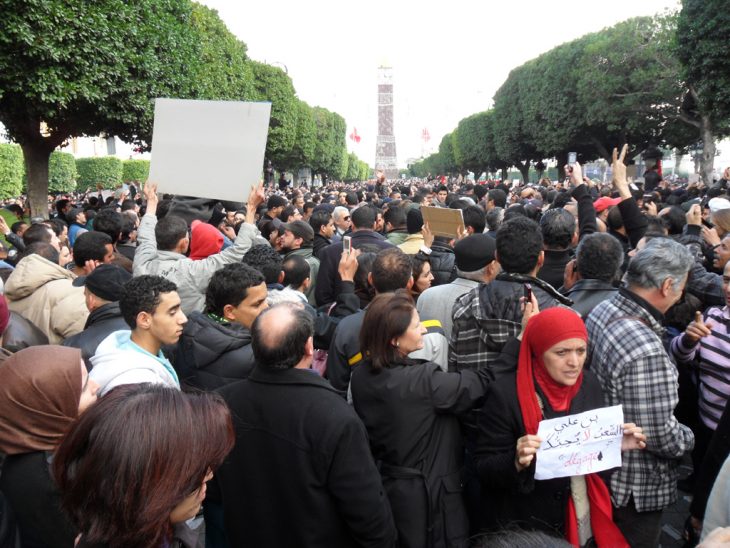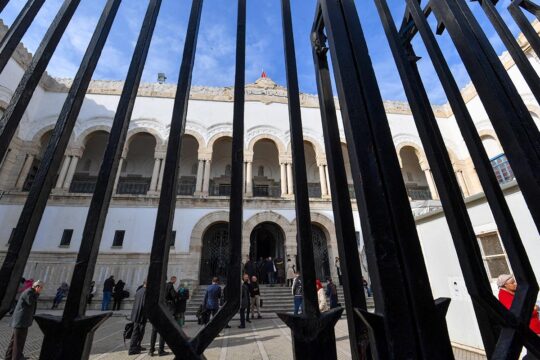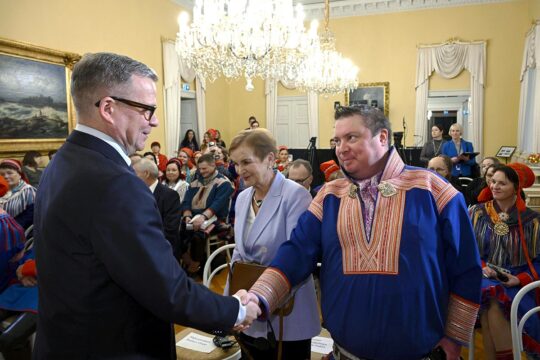Transitional justice is inherently political. It emerges from political concerns, influences politics and power structures. In a transitional society, transitional justice has an important role to play in shaping the ‘new political architecture’,[i] in deciding who may participate in what capacity in future politics, as well as in granting access to material and non-material resources that in turn may facilitate access to decision-making procedures and positions of power. After the uprising in 2010/11 that culminated in the fall of the authoritarian regime of Zine el-Abidine Ben Ali, Tunisia started very early on dealing with its violent, repressive past: first in the framework of existing legislation and later with the development of a planned transitional justice project with international support. Given the political nature of transitional justice, these initiatives of seeking truth, justice and accountability, were not straightforward and met with different kinds of resistance in various stages in the process.
Political resistance through the lens of friction
This article proposes looking at political resistances through the lens of friction. The notion of friction has recently gained traction in peace and conflict studies and transitional justice research.[ii] In physics, friction describes resistance in the encounter between substances, leading to energy production and transformative effects.[iii] Friction is an interaction that connects across difference. Thus, resistance understood as friction can be both productive and disruptive – and these two dimensions are often not easy to distinguish. Applied to the study of transitional justice, the concept of friction as a ‘productive’ dynamic, which is the focus of this article, does not necessarily mean that the ‘transformative effects’ go in a direction that is ‘good’ or preferable from the perspective of certain actors. Rather, it means that the energy is not directed against a certain transitional justice process in general (that would be disruptive), but that it is aimed at influencing the process in a particular direction. Therefore, resistances do not only question transitional justice, they also drive and define it. Moreover, looking at resistance through the lens of friction is particularly useful, because it allows diverting from a perspective that sees one path of transitional justice as the ‘default option’ against which some actors resist. Rather, it allows seeing the process as an open-ended one, which can go into different directions.
Friction as processual characteristic of transitional justice
Frictions, and in particular their conflictual dimension, have been one decisive characteristic that contributed to shape the concrete development of the Tunisian transitional justice process. This is not surprising, given that transitional justice emerges from conflict: had there not been some kind of conflict, there would not be the need for introducing transitional justice measures. In Tunisia, transitional justice as a planned, internationalised process of change interplayed with conflictive transitional politics across all stages of the process: when it was first initiated, when the planned project was designed and when its main institution, the Truth and Dignity Commission (TDC), became operational and transitional justice was performed. Therefore, the transitional justice process was driven and defined by political conflict and friction, and it was subject to different forms of political resistance. In this vein, political resistance to transitional justice in Tunisia was not one-dimensional, but multi-dimensional: it was not necessarily about whether there should be a transitional justice project at all or not. More importantly, frictions emerged over questions of what kind of project should be introduced and what concrete form transitional justice should take.
Thus, political resistance emerged also from actors that were generally in favour of a transitional justice process to take place, but who were unsatisfied with how it took shape. Frictions and, therefore, resistances, relate to the characteristics and features of transitional justice, to how the process should look like, what measures should be employed, how and by whom decisions should be taken and eventually also to the question of what competencies the respective institutions, mainly the truth commission, should have. Moreover, political frictions concerning transitional justice in Tunisia were cross-cutting and cleavages not clear cut. Who formed alliances with whom depended on the issue area. These could transcend common clusters of actors, defined for example by political ideology (‘Islamists’ or ‘secularists’), role in the political system (political actors or civil society), or role in the transitional justice process (e.g. international or domestic actors). Therefore, political resistances to the transitional justice project as a whole – or to certain aspects of it – were non-linear as well.
The frictional politics of nominating truth commissioners
To illustrate these dynamics, a concrete example for productive friction, bringing along several consequences that have subsequently influenced the process, would be friction emerging over the nomination of truth commissioners. The first draft of the Tunisian transitional justice law[iv] was developed in a participatory process, in which civil society actors played a leading role – a method to which politicians and government officials were “not used to”.[v] This draft foresaw that civil society should have also played a role in nominating truth commissioners. However, the National Constituent Assembly (that also functioned as Tunisia’s legislative body at that time) altered the bill before passing it and took the decision to keep the prerogative of nominating truth commissioners to its members and therefore excluded civil society.
“There are suggestions [best practices] for choosing candidates, and civil society should have been involved. […] Civil society was discarded, not present in the process.”[vi]
This decision provoked friction between sections of civil society and the political sphere and was met with resistance from civil society actors who were generally in favour of transitional justice and active within the process. It has driven the development of the process in a particular direction, as it weakened the character of transitional justice as a civil society endeavour and strengthened its political dimension. It established a stronger link between transitional justice and electoral democracy, and the corresponding political institutions, which had important consequences also later in the process. This decision and the resulting frictions then also had influence on defining the character of the Truth and Dignity Commission (and consequently its perception), since a certain group of civil society representatives decided not to propose – or stand as – candidates for the Truth and Dignity Commission.
“So we said, we are not going to propose candidates.”[vii]
This decision was later regretted, when it became obvious that these frictions and resistances had driven the process in a direction with which at least some parts of civil society were not really satisfied:
“Now, in the long run, we have realised, maybe we should have – I speak for myself, personally – we should have maybe proposed candidates.”[viii]
However, the frictions provoked by the decision to nominate truth commissioners within the NCA were not limited to those between the political sphere and sections of civil society. Frictions also emerged between different political actors, as there were disagreements about which nominees should be chosen and what qualities they should have.
“We have achieved [the nomination of the TDC members] with pain and even with some difficulties, given that… Let’s say, there was one party that only wanted partisan members.”[ix]
Later implications of frictional decisions
The example of the early decision to integrate more closely transitional justice with electoral democracy and political institutions shows that political resistances steering the process into a particular direction can have unplanned consequences, also at a later point in time. These implications, then, are also driven and defined by cross-cutting frictions. With a new parliamentary composition in the Assembly of the Representatives of the People, political support for transitional justice within parliament decreased and frictions emerged (or became more noticeable) between politicians and transitional justice actors. They influenced the transitional justice process because the political sphere has had decisive powers over issues that determine the functioning of the truth commission, for example its budget, but also the replacement of defected or dismissed commissioners. These frictions did not always result in open resistance to the project, but sometimes just in non-action:
“Currently, I don’t hide from you that parliament is not very much focused on the question of transitional justice.”[x]
However, these frictions between the political and the transitional justice sphere, that either motivate action or non-action, are more directed against the project in general than trying to steer transitional justice in a particular direction. Thus, they are more disruptive than productive. Eventually, this disruptive trend of political resistance has culminated in the parliament’s decision not to grant the Truth and Dignity Commission an extension that was provided for in the law.
To sum up, looking at political resistances to transitional justice in Tunisia through the lens of friction allows us to identify both the productive and disruptive energies and effects friction (and thus resistance) can have. They can be directed at both transitional justice taking place at all and transitional justice taking place in a particular form. Focusing on productive friction, this article showed how friction, and therefore resistance, was able to drive the process in a different direction and contribute to define how it developed.
[i] Term used in interview by ministerial staff, Tunis, March 2015.
[ii] See for example Björkdahl, Annika & Kristine Höglund (2013) Precarious Peacebuilding: Friction in Global-Local Encounters. Peacebuilding 1(3): 289–299; Kappler, Stefanie (2013) Peacebuilding and Lines of Friction between Imagined Communities in Bosnia-Herzegovina and South Africa. Peacebuilding 1(3): 349–364; and for an application in transitional justice: Buckley-Zistel, Susanne (2016) Frictional Spaces: Transitional justice between the global and the local. In: Annika Björkdahl, Kristine Höglund, Gearoid Millar, Jair van der Lijn & Willemijn Verkoren (eds) Peacebuilding and Friction: Global and Local Encounters in Post-Conflict Societies. Milton Park, Abingdon, Oxon: Routledge. Social science usage of the concept mostly draws on Tsing, Anna Lowenhaupt (2005) Friction: An Ethnography of Global Connections. Princeton: Princeton University Press.
[iii] Cf. Kappler 2013, 251
[iv] ‘Organic Law on Establishing and Organizing Transitional Justice’ in the unofficial English translation provided by the International Center for Transitional Justice.
[v] “But we are not used to these kinds of methods, consultations, etc.” Interview with representative of Ministry of Justice, Tunis, March 2014.
[vi] Interview with civil society representative, Tunis, May 2014.
[vii] Interview with civil society representative, Tunis, March 2015.
[viii] Interview with civil society representative, Tunis, March 2015.
[ix] Interview with NCA member, member of the parliamentary selection committee for truth commissioners, Tunis, May 2014.
[x] Interview with ARP member, Tunis, March 2015.
Note: The paper draws on over five months of field research in Tunisia, accompanying the transitional justice process between 2014 and 2016. It relies on empirical data that comprises about 85 interviews with interlocutors from politics, civil society, government/administration, as well as international organisations and NGOs, both from within and outside the ‘transitional justice scene’. The quotes in this article were translated from French by the author.






